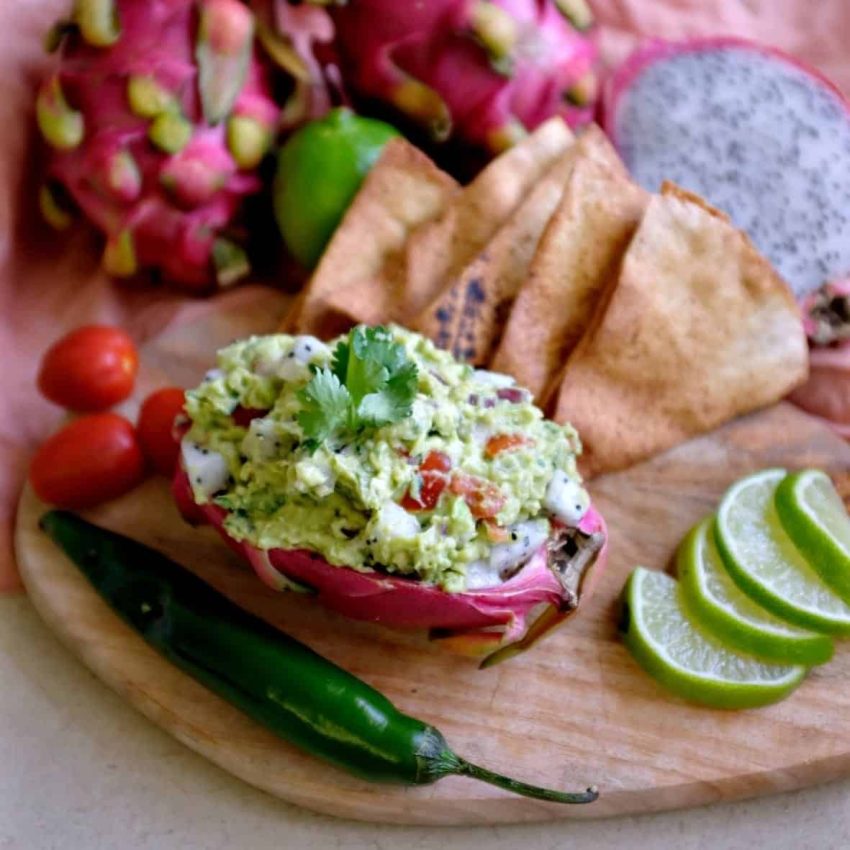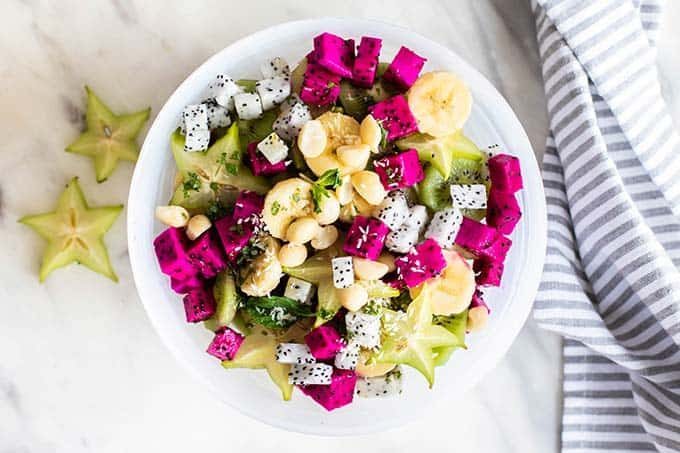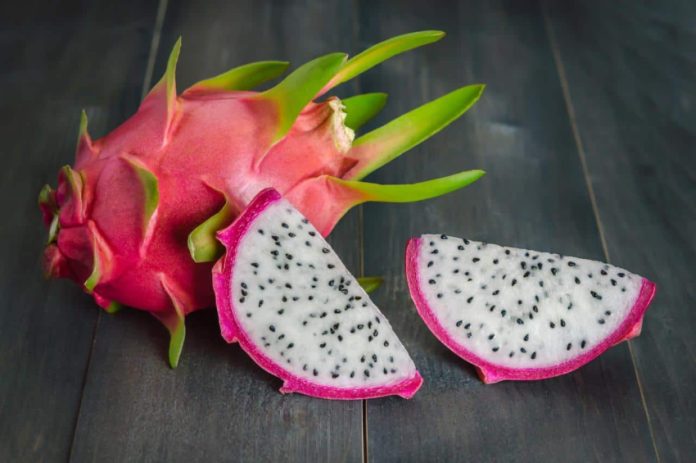Even after so many years, I still love going to the mercado and wandering the aisles looking at everything and everyone. There are a handful of vendors I shop with regularly, and they smile and wave when they see me or hold up something new or different they think I might be interested in.
Such was the case with dragon fruit. Of the several varieties available, the torpedo-shaped type with bright red and neon green “scales” are the most exotic looking. The scaled skin can also be luminous yellow-gold or matte red, and each kind will taste slightly different. In some parts of Mexico, pitaya, another variety, is more common, and although it tastes similar, it is rounder in shape, comes in a rainbow of colors inside and out and is covered with spiky spines that are usually removed before they go to market.

Turns out they are deliciously edible, and you owe it to yourself to try ‘em. This unusual tropical fruit is native to Asia, Central America, Hawaii and Mexico, and grows on the Hylocereus cactus, hanging from the plant’s long spiky fronds like prehistoric Christmas ornaments. The plant, also known as the “Honolulu Queen,” only blooms at night, and once the flowers die, the fruits form. A mature plant can bear fruit four to six times a year, so they may come and go and then suddenly appear again in your local market. Pitayas, though, have a much shorter season and produce for only 6–8 weeks, so buy ‘em when you see ‘em!
Dragon fruit’s unusual bright red skin with chartreuse “scales” are what gives it its name. Inside, the crisp flesh is either white speckled with tiny, crunchy black seeds or a deep, dark pink with the same seeds. Both types are beautiful added to a fruit salad or smoothie, and also work well eaten alongside something salty and savory or as a palate cleanser between courses. Dragon fruit’s mild flavor is a sweet mix of watermelon and pear, with a delicate, tantalizing floral aroma. Commercial growers cultivate big fields of dragon fruit, but it’s also possible to grow the plant at home, in the ground or in large pots. Dragon fruit is high in antiinflammatory antioxidants, low in calories and naturally contains probiotic bacteria that promote gut health.
Ripe dragon fruit will be firm but give slightly when squeezed, like an almost-ready avocado. They’ll also have a sweet aroma, like a ripe peach. Store ripe fruit in the refrigerator until eating or using. Wash carefully, then simply slice it in half lengthwise; there’s no pit, and the crunchy black seeds are edible and fun. Next, either scoop out the flesh to use in a recipe or eat as-is with a spoon. If you like, save the shell to use as a dish for guacamole, fruit salad, etc. The deep pink-fleshed variety will have the most “wow” in a recipe, but the white-fleshed type is just as delicious and makes almost as unusual a presentation. You’ll be happy to add dragon fruit to your roster of regulars in the kitchen!
Dragon Fruit Margarita
- 1 dragon fruit (with pink flesh if possible)
- ¼ cup fresh lime juice
- 1 shot of honey or simple syrup
- 2 shots tequila
- 1 cup ice
Slice dragon fruit in half, scoop out the flesh and add to a blender with lime juice, honey/syrup, tequila and ice. Blend on high until combined, divide between 2 glasses and serve.
Dragon Fruit Salsa
- 1 cup dragon fruit, cubed
- ½ red or white onion, chopped
- 5 sprigs cilantro, minced
- 1 Tbsp. fresh lime or lemon juice
Combine all ingredients and mix gently. Let stand an hour or so to blend flavors.
Dragon Fruit Guacamole

- 3 medium avocados
- ½ cup diced dragon fruit
- ½ cup chopped fresh cilantro
- 1/3 cup chopped red onion
- 2½ Tbsp. fresh lemon or lime juice
- Salt to taste
Using a fork, mash avocados in a bowl. Add lime/lemon juice, cilantro, onion and salt to taste. Fold in dragon fruit. Serve immediately with tortilla chips.
Berry Dragon Fruit Salad

- 2 dragon fruits, white or red, scooped with a melon baller
- 1 pint strawberries, halved
- 1 pint blackberries or raspberries
- 1 pint blueberries
- 6 mint leaves, minced
Combine fruit in a medium bowl and stir gently. Top with mint leaves and serve.
Asian Shrimp & Dragon Fruit Salad
- 1 dragon fruit
- 8 large shrimp, deveined and skins removed
- 3 cups spring salad mix or other lettuces
Dressing:
- 3 Tbsp. plum or hoisin sauce*
- 2 tsp. apple cider or rice vinegar
- 1 Tbsp. honey
- 1 tsp. water
- Small bunch of fresh cilantro leaves roughly chopped
- ¼ red onion, thinly sliced
- Toppings: 1 Tbsp. sesame seeds, ¼ cup roasted peanuts unsalted
Prepare dressing by mixing the ingredients in a bowl; set aside. Cut dragon fruit in half, peel off the skin and cut flesh into large cubes; set aside in refrigerator.
Steam the shrimp over high heat for about 2 minutes or until pinkish and cooked through. Cool.
Place greens in large bowl. Add onions, cilantro, cooked shrimp and dragon fruit. Drizzle with dressing just before serving and sprinkle with sesame seeds and peanuts.
* If plum or hoisin sauce are not available, try teriyaki sauce or, in a pinch, apricot or peach jam mixed with 1 tsp. minced fresh ginger.
Janet Blaser is the author of the best-selling book, Why We Left: An Anthology of American Women Expats, featured on CNBC and MarketWatch. She has lived in Mexico since 2006. You can find her on Facebook.
